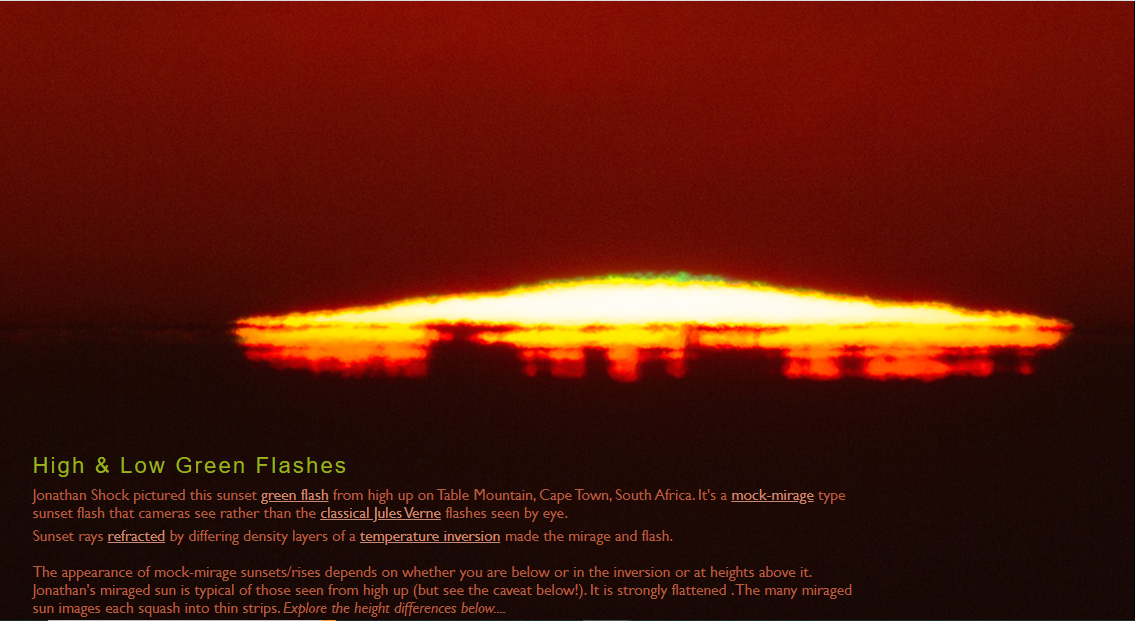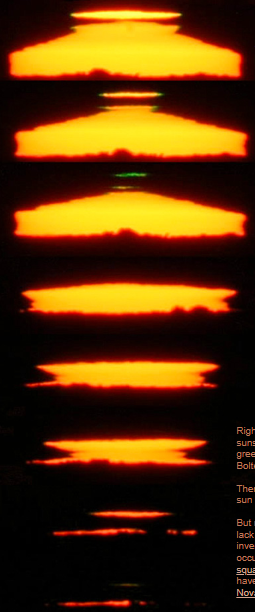High & Low Green Flashes
High & Low Green Flashes: A Closer Look at Atmospheric Optics
When it comes to atmospheric optics, one phenomenon that captures the imagination is the elusive green flash that sometimes occurs during sunrises and sunsets. These flashes are not only a visual delight but also provide insights into the complex interplay of light and atmospheric conditions. In this article, we will delve deeper into the world of high and low green flashes, exploring the factors that influence their appearance and the variations observed at different altitudes.
The Mirage and Flash: Understanding the Mechanism
Green flashes are caused by the refraction of sunlight as it passes through the Earth's atmosphere. The bending of light rays is influenced by varying density layers in the atmosphere, particularly temperature inversions. These inversions occur when a layer of warmer air is trapped above cooler air, creating a boundary where light rays can be refracted in unique ways.
At higher altitudes, where observers are positioned above the inversion layer, a phenomenon known as a mock-mirage sunset or sunrise can be witnessed. These mock-mirages are characterized by flattened images of the sun, resembling thin strips rather than a full disk. This distortion occurs due to the strong refraction of light passing through multiple layers of differing densities.
Contrasting High and Low Altitude Views
The appearance of green flashes can vary depending on the observer's altitude in relation to the inversion layer. Let's explore the differences observed between high and low altitude views:
High Altitude Views
Photographs taken from elevated vantage points, such as Table Mountain in Cape Town or Monte Novegno in Vicenza, showcase stunning examples of mock-mirage green flashes. These images reveal the highly flattened shape of the sun as it sets or rises. Each slice of the miraged sun appears compressed into thin strips, creating a mesmerizing visual display.
Low Altitude Views
At lower altitudes, where observers are either within or below the inversion layer, the appearance of green flashes can be different. In these cases, the mirage exhibits less vertical compression, allowing for a more recognizable shape of the sun. Images captured at locations like the Southern California coast or Jakobstad in Finland show the sun slices with minimal distortion.
Factors Influencing Compression
While low-level mock-mirages generally exhibit less compression, there are instances where strong inversions and ducting occur, resulting in severely squashed sunsets. In extreme cases, such as the Novaya Zemlya sunrise/sunset, multiple stacked lines can be observed. These unique phenomena highlight the complexity of atmospheric conditions and their impact on the appearance of green flashes.
Exploring Atmospheric Optics Through Visual Media
In addition to static images, videos also provide a captivating medium to observe and study green flashes. Michael Bolte's video of a Californian sea-level sunset mirage with intermittent green flashes showcases the continuity of the phenomenon, offering valuable insights into its behavior over time. These visual records contribute to our understanding of atmospheric optics and aid in further research and analysis.
Conclusion
The world of atmospheric optics never ceases to amaze, and green flashes are a testament to the captivating interplay between light and the Earth's atmosphere. By exploring high and low altitude views of these phenomena, we gain a deeper appreciation for the complexity of their appearance. Whether witnessed from mountain peaks or coastal shores, green flashes continue to mesmerize observers worldwide, reminding us of the beauty and intricacy of our natural world.

High & Low Green Flashes
Jonathan Shock pictured this sunset green flash from high up on Table Mountain, Cape Town, South Africa. It's a mock-mirage type sunset flash that cameras see rather than the classical Jules Verne flashes seen by eye.
Sunset rays refracted by differing density layers of a temperature inversion made the mirage and flash.
The appearance of mock-mirage sunsets/rises depends on whether you are below or in the inversion or at heights above it. Jonathan's miraged sun is typical of those seen from high up (but see the caveat below!). It is strongly flattened . The many miraged sun images each squash into thin strips. Explore the height differences below....
Image ©Jonathan Shock, shown with permission

A mock-mirage sunrise and green flash seen from a height. This time from Monte Novegno (1691m), Vicenza, Italy by Pierluca Grotto.
Each miraged sun slice is well flattened.

Left: Sunset series from the ESO La Silla Observatory, high (2400m) in the Atacama Desert, Chile. Image by Jes�s Ma�z Apell�niz.

Right: A mock-mirage sunset and green flash at near sea level. Seen on the Southern California coast by Jim Grant.
The mirage has far less vertical compression. Jim was likely within the inversion.

Right: Another Californian sea-level sunset mirage with intermittent green flashes. Videoed by Michael Bolte.
There is little compression of the sun slices.
But not all low-level mock-mirages lack compression. When the inversion is strong and ducting occurs then we see a severely squashed sunset. In extremis we have the multiple stacked lines of a Novaya Zemlya sunrise/sunset.
Below: There is almost no vertical distortion in the early stages of this low-altitude sunset mock-mirage. Imaged at Jakobstad, Finland by Jonas F�rste

Note: this article has been automatically converted from the old site and may not appear as intended. You can find the original article here.
Reference Atmospheric Optics
If you use any of the definitions, information, or data presented on Atmospheric Optics, please copy the link or reference below to properly credit us as the reference source. Thank you!
-
<a href="https://atoptics.co.uk/blog/high-low-green-flashes/">High & Low Green Flashes </a>
-
"High & Low Green Flashes ". Atmospheric Optics. Accessed on November 26, 2024. https://atoptics.co.uk/blog/high-low-green-flashes/.
-
"High & Low Green Flashes ". Atmospheric Optics, https://atoptics.co.uk/blog/high-low-green-flashes/. Accessed 26 November, 2024
-
High & Low Green Flashes . Atmospheric Optics. Retrieved from https://atoptics.co.uk/blog/high-low-green-flashes/.